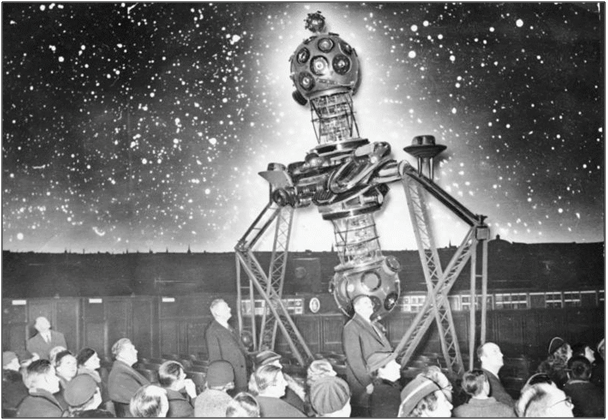GAM 2017 Blog
- Published: Wednesday, April 05 2017 06:03
By Shane Hengst
Brief and selective history of the Planetarium
Planetaria (or planetariums) have historically been known for showing the motion of the night sky on the inside of a dome that is projected by electromechanical (or optical) technology. Traditional ‘Starballs’, made popular by Zeiss, arguably gave the best and the sharpest view of the stars that were almost as good as the real thing. Throw in a few static images of constellations with a kick-ass presenter and you have one hella of a show! This planetarium experience has been dazzling crowds for almost a century. Figure 1 shows the Zeiss Starball projector in action way back in 1939.
 Figure 1: A Zeiss Starball projector at a Berlin planetarium in 1939 (Photo: Frankl, A.)
Figure 1: A Zeiss Starball projector at a Berlin planetarium in 1939 (Photo: Frankl, A.)
Enter the digital era! The onset of the digital projectors in the 80s started a shift towards more versatile shows but with one drawback of a lower resolution to its electromechanical counterpart. However, in recent years, the tech has developed so far that they are now approaching ‘the limit of human visual acuity’!
 Figure 2: New digital projection systems are now dominating planetaria, like this one in Melbourne. (Source: www.museumvitoria.com.au)
Figure 2: New digital projection systems are now dominating planetaria, like this one in Melbourne. (Source: www.museumvitoria.com.au)
But, so what!?! If you want to experience a great night sky, just go out on a clear night away from city lights and simply look up! (Highly recommended to do it!) Stargazing, in relation to planetaria, is great but has a limited scope – ‘astronomically’ speaking!
With the onset of digital projectors, the amount of content for full-dome presentations and versatility has grown exponentially! Modern planetaria are not only entertaining and educational but (to a lesser known degree) they are capable of conducting experiments. Here I propose as a triple threat that planetaria can offer:
1. Entertainment
This is notably has been done very well and probably the most familiar for those have been inside this immersive environment. The experience has perhaps been made popular with the fixed full domes. Check out the STEMpunk interview with Warik Lawrance, a production designer, discussing about the importance of narrative with use of a planetarium.
2. Education
The use of the planetarium has been very effective for outreach – i.e. the raising awareness of science to the public. Certainly, school groups can take full advantage of this in the big cities that are host to big fixed domes. Let’s not forget the portable operators doing their part in the city and remote areas. These include Starr Planetarium Education Group in Sydney and Night Sky Secrets operating in Northern Queensland just to name a couple in Australia. For more details on portable planetariums and how they are an invaluable asset for Outreach, see my previous 2016 GAM blog.
There is, however, another aspect of education of the planetarium that I believe is being under utilised whereby exploiting the planetarium to teach regular classes. Not just in astronomy but in a variety of other subjects. Changing the regular-o classrooms to an impressive planetarium setting.
3. Experimentation
Lastly, the usage of Planetarium in research. How? Or, more importantly why?
I see specific areas of research where a planetarium can assist in: 1. Visualisation of data and 2. Conducting research experiments.
Instead of using a flat screen, which is essentially is 2D. The real world is 3D. The flat screen can render 3D graphics but its nothing compared to the ‘curved’ screen of the dome! This platform would very effective in the visualisation of either observational or simulated data. Examples in astronomy would include the dynamics of solar system objects and the formation of galaxies. Non-astronomical examples would include exploring the human body and looking at chemical modelling; see Figure 3 for an example of blood cells flowing in the human body
 Figure 3: Still from the full dome production ‘The Human Body’. (Source: www.buofulldome.com)
Figure 3: Still from the full dome production ‘The Human Body’. (Source: www.buofulldome.com)
A planetarium can be another tool for a scientist to use in conducting an experiment. Research has even been undertaken for the potential to conduct research in fulldome immersive environments; see: http://dl.acm.org/citation.cfm?id=2240728 – although this research paper focuses on psychological experiments it certainly does provide great potential for experiments to be conducted across all sciences.
Where would be a good place?
The current locations of large fixed domes are typically attached with a museum. A couple of examples are Melbourne Planetarium at Science Works and the SciTech facility in Perth. (These are great facilities and I would highly recommend in getting to them!). However, I would argue that these facilities would not be able conduct regular classes and to fully embrace the research angle because their primary focus is entertainment and educational outreach. Thus, I believe the prime location for a planetarium would be at a university!
A university is a great venue that already provides entertainment (through orientation week activities, public events and music groups, etc). Universities provide education programmes such as the teaching degrees and school engagement through their Outreach. Finally, universities have a plethora of academics that are constantly conducting experiments. Thus, universities can provide the appropriate location for allowing planetaria to reach their full potential!
A large full dome would be most ideal in a big city connected with a large university to take full advantage of the full planetarium experience. I am looking at you, SYDNEY!
About the Author
Shane’s goal is to raise the awareness of science, in particular physics and astronomy, to the community. Shane likes to do some research and he is currently a part-time PhD student studying debris discs in planetary system. He is the current president of the Australasian Planetarium Society.








